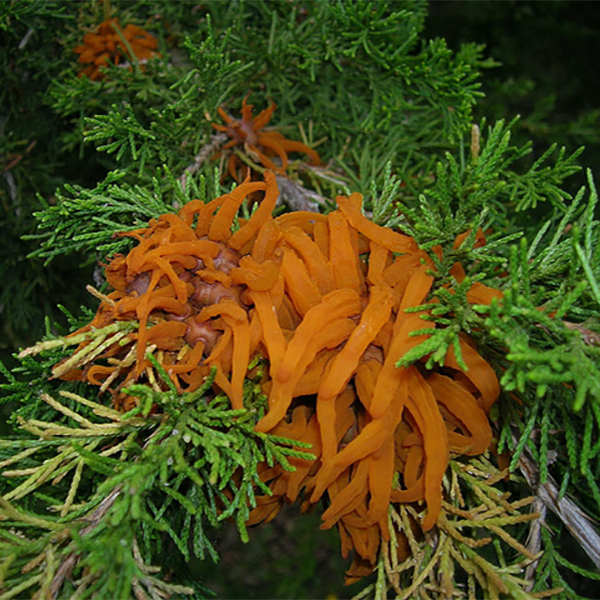
Cedar apple rust is caused by Gymnosporangium juniperi-virginianae, a fungus that needs both a cypress-related evergreen plant and an apple-related plant to complete its lifecycle. Incidence and severity of the disease varies from year to year and is more prevalent in very wet springs and very humid summers. If you have both host plant types in your yard and find symptoms on one, you should look for symptoms on the other as well. There are related rusts on quince, hawthorne and serviceberry for which you can follow these guidelines.
SYMPTOMS
Junipers: Junipers, cedars, and arborvitae are evergreen hosts for cedar apple rust. Eastern Red Cedar is the most common. The disease is more of a health threat to them than to apples because the lesions can strangle and kill infected branches. Even so, cedar apple rust is not considered life-threatening for its evergreen hosts. They are infected in late summer and autumn and form greenish brown or rusty brown galls as small as 1/16” or as large as 2”. Most people notice a gall when it swells during spring rains and becomes a bright orange gelatinous mass perhaps 1” to 3” wide, sometimes with tentacles that make it look as if “it came from outer space”. This mass produces spores that can travel long distances but usually infect apples within a few hundred feet. Broad junipers in the chinensis family (such as ‘Pfitzeriana’) and horizontalis groundcover junipers (such as ‘Wiltonii’) may be somewhat cedar apple rust resistant. Narrow uprights may be more susceptible.
Apples: On apples, cedar apple rust is generally an appearance issue rather than a life threatening disease. An untreated infected apple tree can stand defoliation year after year, although eventually it will be weakened and may eventually succumb to other pests. Apple trees are infected in the spring when spores from the juniper hosts land on new leaves. The home owner usually doesn’t notice the spots created by infection until the fungus is advanced to its next reproductive stage in midsummer. Spots enlarge and often develop a distinctive red band around the circumference. Eventually the underside of the spot will develop spidery fingers about 1/8” long that produce new spores to infect host junipers. Some apple cultivars are slightly more resistant and have smaller or fewer lesions. Among the crabapples Malus ‘Adams’, ‘Donald Wyman’, ‘Prairifire’, ‘Profusion’, ‘Snowdrift’, and ‘Sugartyme’; M. floribunda; M. sargentii and its cultivar ‘Tina’; and M. x zumi var. calocarpa are somewhat resistant. Among orchard apples ‘Baldwin’, ‘Cortland’, ‘Gravenstein’, ‘Liberty’, ‘Macintosh’, and ‘Red Delicious’ are somewhat resistant.
TREATMENT
FOR APPLE HOSTS: Once infected, no treatment is effective on the current year’s foliage. Preventative treatment, however, is very effective.
Late Winter: Dormant oil should be applied in the late winter to smother overwintering spores on bark, branches, twigs, and buds.
Spring: A fungicide should be applied following package directions, usually when the flower buds turn pink, again when the petals have fallen, and once more about 10 days later. A light spray on the soil below the plant might help as well.
Fall: Thorough clean-up of all fallen leaves will greatly reduce the source of new spores the following spring. Get the leaves off your property if at all possible rather than putting them in your compost.
FOR EVERGREEN HOSTS: Pruning out lesions is the most effective way to reduce infection. Disinfect pruners between cuts (dip into a solution of 1 quart water with 2 tablespoons bleach). No chemical treatment is completely effective but application of a fungicide may be somewhat effective in reducing lesions.
FUNGICIDES
FOR APPLE HOSTS: Be sure to check if the fungicide you plan to use is safe for food crops. The following are appropriate for food crops.
CAPTAN: Bonide’s Fruit Tree Spray, Ortho’s Home Orchard Spray, Fruit Guard, Captan, Orthocide
CHLOROTHALONIL: Bonide’s Fung-onil Multipurpose Fungicide, Daconil 2787, Ortho’s Multipurpose Fungicide
FERBAM: Carbamate 76WP, Ferbam; use in early spring since it leaves an unsightly residue
MANCOZEB: Dithane DF, Dithane M45, Manzate, Mancozeb Flowable
MYCLOBUTANIL: Spectracide IMMUNOX
FOR EVERGREEN HOSTS ONLY: You may use any of the above fungicides on an evergreen host as well as those listed below. PLEASE NOTE, the following fungicides are NOT appropriate for food crops.
DIMETHYL 4,4-o-PHENYLENEBIS: Bonomyl
PROPICONAZOLE: Bonide’s Fung-onil Lawn & Garden Disease Control, Ortho’s Lawn Disease Control, Banner
TRIADIMEFON: Bayleton









